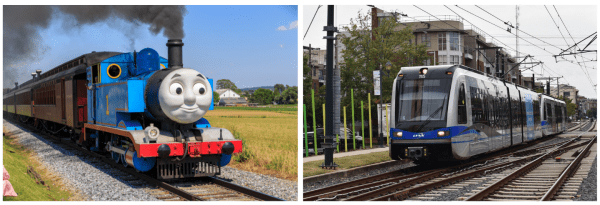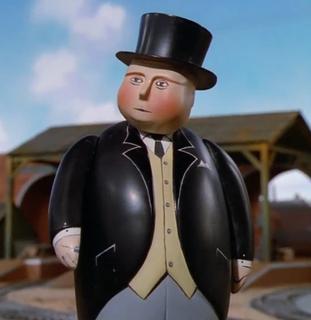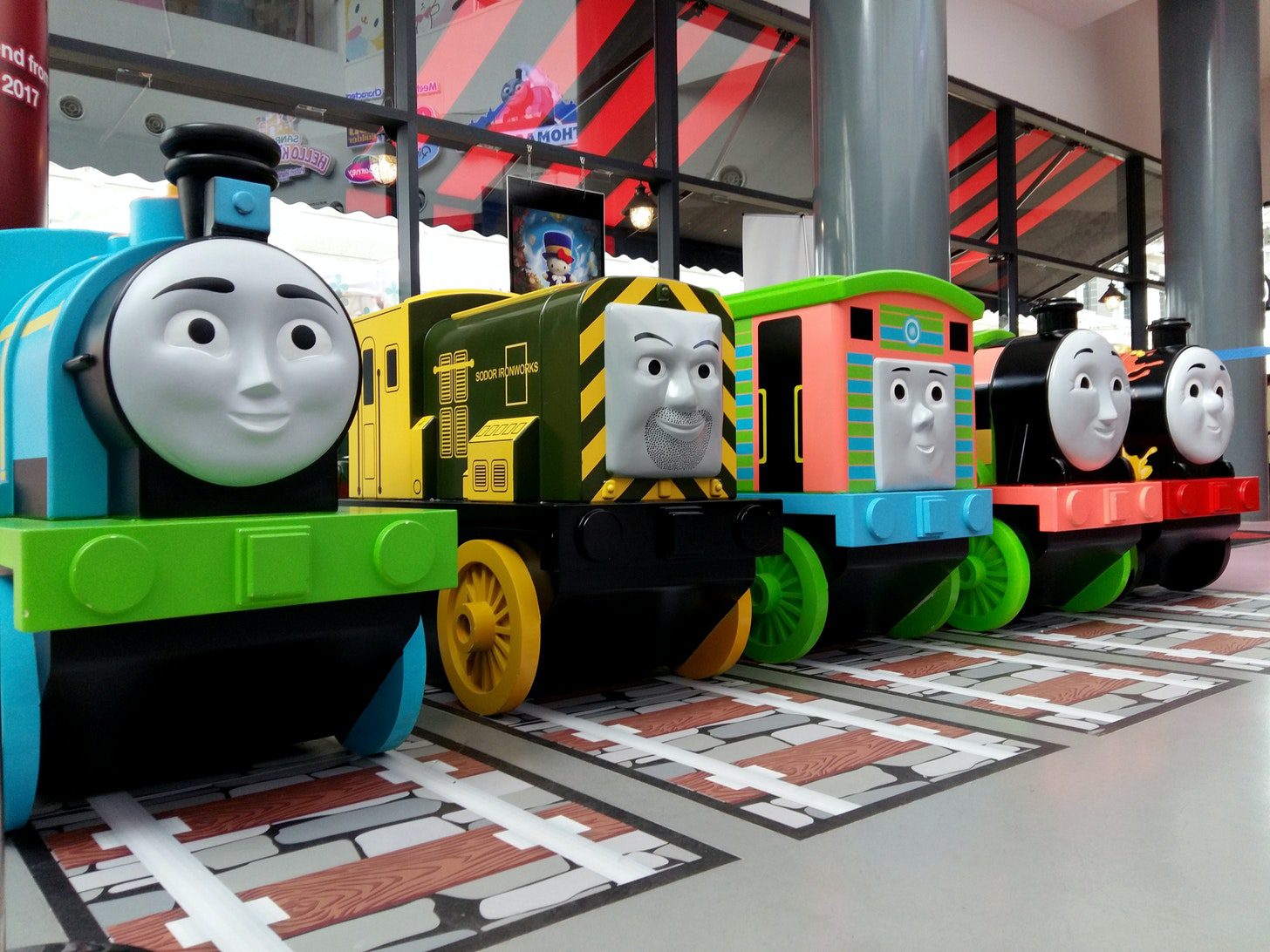Opinion: What can Charlotte learn from ‘Thomas the Tank Engine’?

Editor’s note: This story originally appeared in Transit Time, a weekly newsletter produced in partnership by the Urban Institute, The Charlotte Ledger and WFAE.
On the surface, Charlotte — a fast-growing, finance-powered, landlocked metropolitan region — might appear to have little in common with Sodor, a fictional island off the coast of England with a coal- and agriculture-based economy.
But, as a “Thomas the Tank Engine” fan in my youth — and as the father of a Thomas-addled toddler — I’ve had plenty of time to contemplate the similarities. I was railway magnate Sir Topham Hatt for Halloween. I’ve seen or read pretty much every piece of Thomas content to my son. And I’m here to tell you: Thomas the cheeky blue train and the rest of the Sodor crew have things to teach us.
If you have somehow missed this cultural phenomenon in the last few decades, allow me to bring you up to speed. Thomas the Tank Engine started as the “The Railway Series,” a story collection published in the late 1940s by the Rev. W. Awdry, an English Anglican priest. In the 1980s, Thomas spawned a live-action British animated series (voiced, weirdly enough, by Ringo Starr and later George Carlin) and “Shining Time Station,” an American PBS show.
Thomas is still on the air as a computer-animated series of TV shows and movies, along with an endless selection of toys, books and other merch. Most of the stories revolve around a railroad challenge — for example, Thomas is late picking up an opera singer from the docks because he’s busy splashing in puddles — that has to be solved by teamwork, friendship and wisdom from an authority figure.
(Silliness disclaimer: Obviously, this column isn’t that serious. If you want something more serious, check out this story from last week about the transit tax’s prospects for getting on the ballot in Mecklenburg County next year.)
Lesson 1: Embrace buses
If Sodor’s transit system has an Achilles heel, it’s that the system seems to be nearly 100% train-based. Although Sir Topham Hatt (the railway executive known, in earlier, less politically correct iterations of the show as “the fat controller”) has built rail lines to every corner of his island, there’s limited flexibility.
Reaching any new locations requires building an expensive new branch line. Plus, everything, including small items such as strawberries for the night’s pie, has to move in boxcar-sized quantities.
The island’s erstwhile pair of buses, Bertie and Bulgy, sometimes race Thomas and the other trains. But more often than not, Sir Topham Hatt cautions them not to try to usurp the primacy of trains, even threatening Bulgy with being turned into a henhouse at one point for getting out of line (which would be a huge waste of a capital investment). The message is clear: Buses are fine as an emergency if a passenger train breaks down, but you shouldn’t ride the bus if you can help it.
It’s not clear why Sir Topham Hatt is so stridently opposed to buses. It’s possible he’s using his monopolistic power and friendship with the Earl of Sodor to reduce competition and extract the maximum fares and freight fees from the people of Sodor.
[Read more: Overcoming the ‘stigma’ of riding the bus]
But in Charlotte, a city seeking to reverse years of falling bus ridership and expand the bus network, we sometimes see a similar attitude. Buses are viewed as a mode of last resort, stigmatized and ignored in favor of flashier trains. If we want to build a truly far-reaching and economically viable transit system in the near future, we — like Sir Topham Hatt — should change our attitude toward the bus.
Lesson 2: Invest in infrastructure and maintenance
For an island completely dependent on trains, Sodor suffers a shocking number of rail mishaps. Bridges crumble, rail-building projects accidentally dynamite and collapse huge underground caves to expose hidden pirate ships, faulty signals send freight cars careening into passenger trains and off overpasses. Trains are constantly breaking down and having to head to the Sodor Steamworks to repair blocked funnels and bent buffers, presumably putting them out of service for days.
Maybe Sir Topham Hatt should spend less on building additional branch lines and more on basic maintenance for the rail system he already has.

Should Sir Topham Hatt spend more on maintenance than on new construction? Should Charlotte?
In Charlotte, our infrastructure problems might be less serious, but we have plenty of challenges around maintenance, even as we seek to expand. The Charlotte Area Transit System’s trains on the Blue Line are reaching midlife, and the agency announced last year that it needed to spend $30 million to $50 million for extensive maintenance to prevent future delays, overhauling the vehicles two at a time in Sacramento.
The new Gold Line has already had several brief delays due to mechanical problems, according to CATS. As Charlotte considers investing billions into new rail lines and a bigger bus fleet, staying ahead of maintenance to preserve reliability in order to attract riders to the system we already have will be key.
Lesson 3: Land use can make or break transit
OK, Sodor — a sparsely populated, rural island dotted with farms — might not seem like the ideal place to build a transit-centered society. And I’ll admit, having a train stop at pretty much every farm probably isn’t a realistic or economically sound expectation. But leaving out the countryside, the connections between Vicarstown, Knapford and other key settlements work well because towns in Sodor are designed compactly, with pedestrian- and bicycle-friendly streets, where people live near the train station. Sodor’s railways wouldn’t work if the island was built up into a series of sprawling suburbs (unless Sir Topham Hatt built a train to every cul-de-sac, which, let’s be honest, he might).
Sodor is a good reminder that there’s more than one key ingredient in a successful transit system. Building in transit-supportive ways around the infrastructure we invest in is an important part of the mix.
Lesson 4: Beware the stagnation of entrenched systems and sunk costs
Despite the train-friendly — even train-obsessed — atmosphere on Sodor, I’m not sure you could call the North Western Railway a great success. Thomas is set in a time when helicopters and jets exist, but the NWR is still mainly relying on coal-fired steam engines, with manual switches staffed by workers in shacks along the tracks.
Sir Topham Hatt’s technological investments appear limited to a few diesel engines, and there’s no effort to make the railway more efficient or environmentally friendly (the greenhouse gas emissions of Thomas and his steamy friends make one shudder). Maybe because it’s an island, or maybe because Sir Topham Hatt jealously shields his anthropomorphic fleet of trains from any real innovation to guard his status as Sodor’s big fish, but the North Western Railway is mostly frozen in amber.
 Just because Sodor relies on a fleet of steam engines to get things done doesn’t mean that Charlotte has to stick to the way it has always thought about trains and transit.
Just because Sodor relies on a fleet of steam engines to get things done doesn’t mean that Charlotte has to stick to the way it has always thought about trains and transit.
And that’s worth keeping in mind as we look to the future in Charlotte. Innovative ideas like hydrogen-powered trains, and even more far-fetched ones like Elon Musk’s tunnels of autonomous Teslas, are sometimes easy to scoff at. It’s true that we shouldn’t be wide-eyed naifs embracing every flashy new idea, but sticking only to what we know — whether that’s heavy, diesel commuter trains on the Norfolk Southern freight tracks or the same size and types of buses we’ve used for decades — would be a mistake.
So, when it comes to building Charlotte’s transportation future, the talking trains (and buses, planes, boats and cranes — everything there talks) of Sodor might offer a few lessons. If nothing else, they serve as a reminder: Make transit “really useful,” and the rest will probably work itself out.
Below: The author at age 4, dressed as Sir Topham Hatt.
